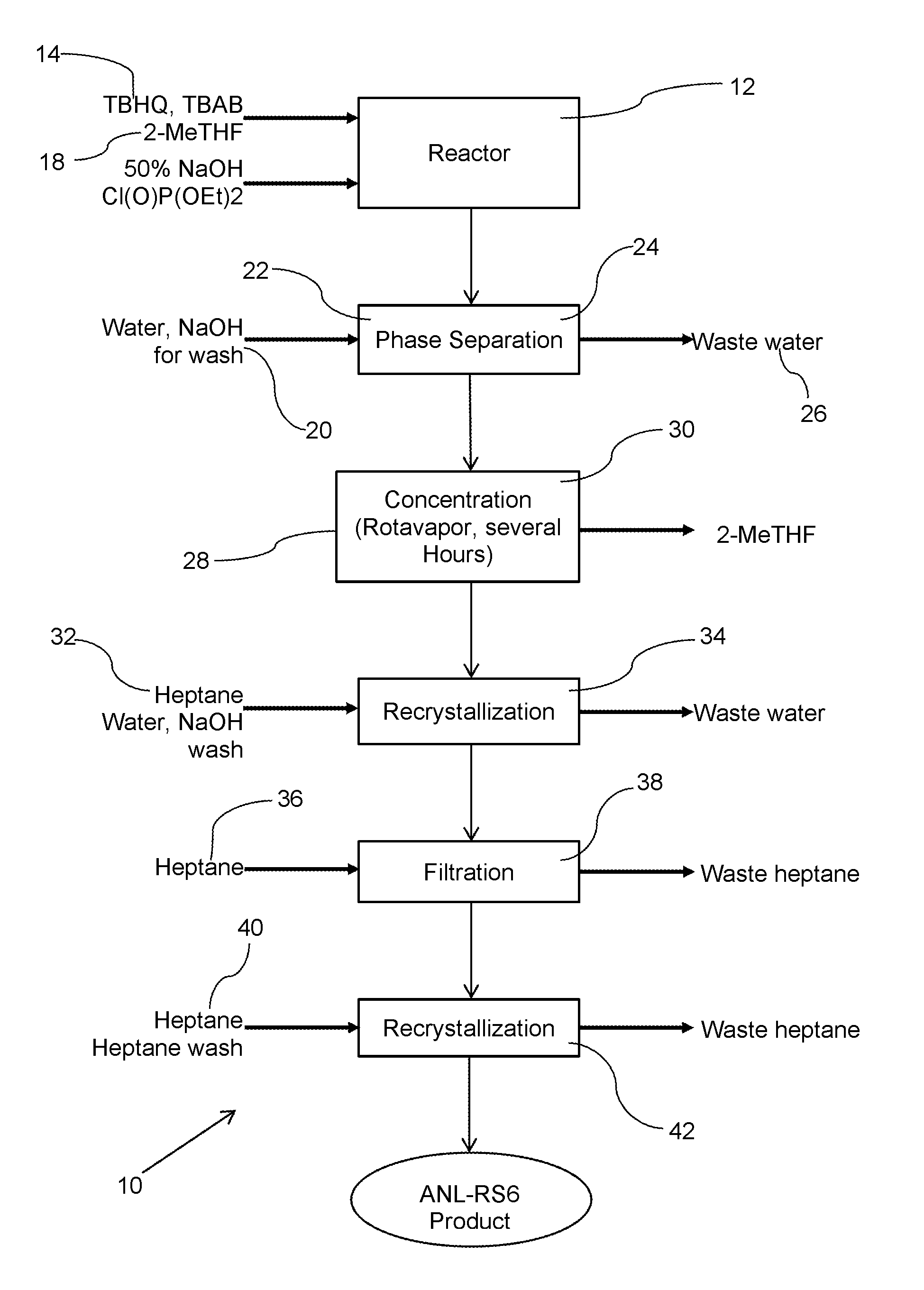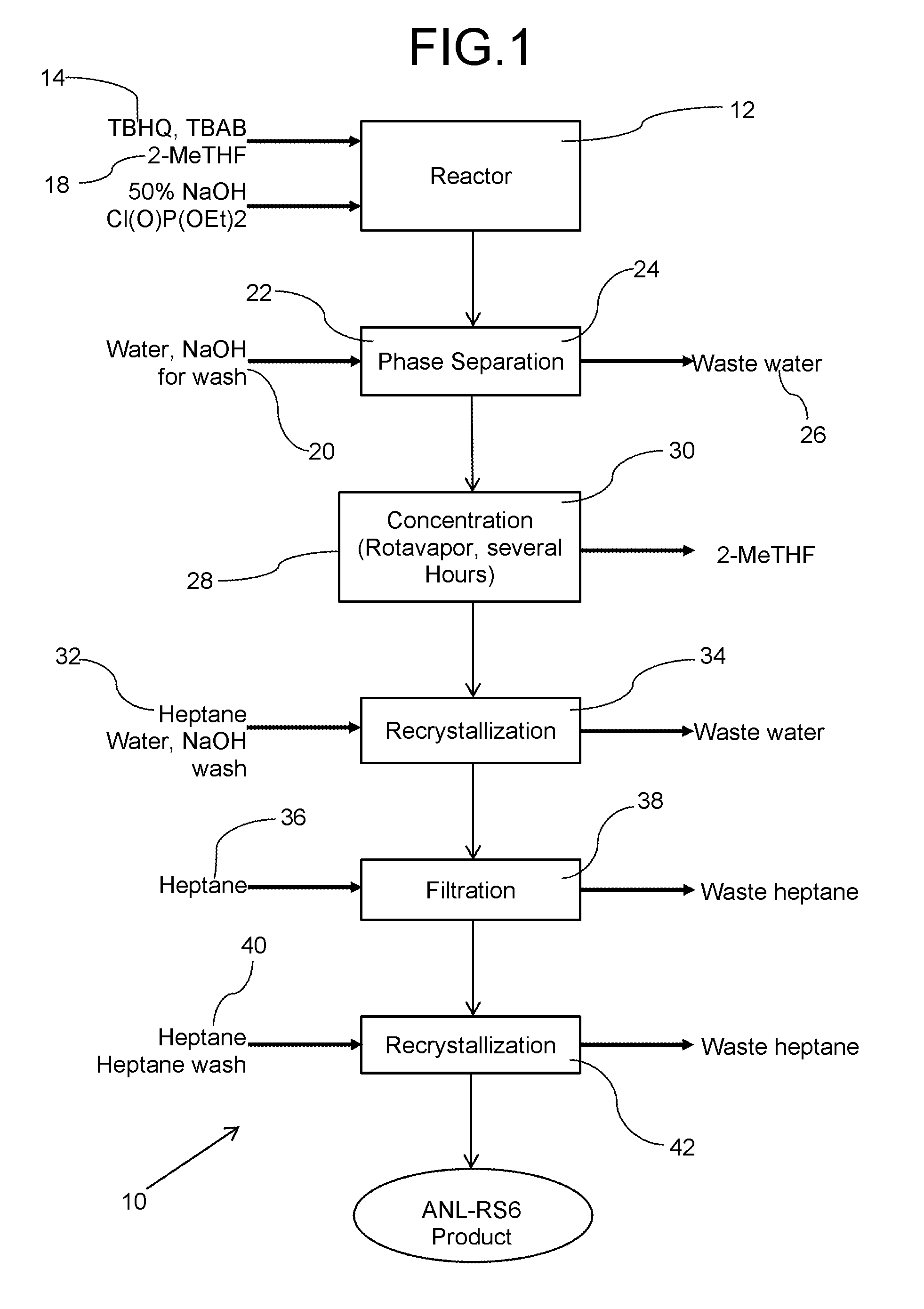Method for producing redox shuttles
a redox shuttle and redox technology, applied in the field of large-scale redox shuttle production, can solve the problems of multi-step process, inert environment and expensive reagents, and large yield, and achieve the effect of inherent safety
- Summary
- Abstract
- Description
- Claims
- Application Information
AI Technical Summary
Benefits of technology
Problems solved by technology
Method used
Image
Examples
example 1
[0055]Specific amounts of reactants are determined empirically to affect these changes to the hydroquinone feedstock.
[0056]Table 1, infra provides specific amounts for illustrative purposes in the production of about 31 kilograms of the desired shuttle, herein designated by its tradename RS6™.
[0057]
TABLE 1Reactant Amounts to produce redox shuttle RS6 ™Amount (kg)Capacity (L)Rate (L / h)Temp (° C.)RPMSolid Feed 1: TBHQ17Solid Feed 1: TBAB0.77Pump 1: 2-MeTHF140200200Pump 1: 50% NaOH1217Pump 1: Chlorophosphate35Pump 1: Water17Reactor 1400 10-110Mixer 10 to 150Aqueous Waste tank29100Reactor 2400 10-110Mixer20 to 150Pump 2: Water34530Pump 2: Heptane156230Aqueous Waste 134100Distillate tank140200Filter 1(40)100Organic Waste Tank 1156200Reactor 3400 10-110Mixer 30 to 150Pump 3: Heptane156400Product Filter / Drier5010-50Organic Waste Tank 2156200Product RS631
example 2
[0058]A glass reactor (20 L, jacketed, Chemglass) equipped with drain valve, internal temperature probe, reflux condenser, gas inlet / outlet adapters and powder port was flushed with argon. The jacket of the reactor was connected to a Huber 430 heating / chilling circulator. An argon flow was continued to inert the reactor.
[0059]2,5-di-tert-butylbenzene-1,4-diol (1010 g, 4.5 mol, Aldrich MKBG8404V) and tetrabutylammonium bromide (45.2 g, 0.13 mol, Aldrich MKBG5872V) were charged to the reactor. 2-Methyltetrahydrofuran (10 L, MKBG1620V) was added to the reactor and the stirrer was started. The temperature control unit was set to 27° C. and started. A 50% aqueous solution of sodium hydroxide (1470 g, 18 mol, Aldrich MKBG1414) was added, turning the solution an orange color. A peristaltic pump was set up to deliver diethyl chlorophosphate (2038 g, 11.8 mol, TCl lot NFJTB) over a 70 minute period.
[0060]By the end of the addition, the reaction had turned color from orange to light yellow to...
PUM
| Property | Measurement | Unit |
|---|---|---|
| temperature | aaaaa | aaaaa |
| temperature | aaaaa | aaaaa |
| temperature | aaaaa | aaaaa |
Abstract
Description
Claims
Application Information
 Login to View More
Login to View More - R&D
- Intellectual Property
- Life Sciences
- Materials
- Tech Scout
- Unparalleled Data Quality
- Higher Quality Content
- 60% Fewer Hallucinations
Browse by: Latest US Patents, China's latest patents, Technical Efficacy Thesaurus, Application Domain, Technology Topic, Popular Technical Reports.
© 2025 PatSnap. All rights reserved.Legal|Privacy policy|Modern Slavery Act Transparency Statement|Sitemap|About US| Contact US: help@patsnap.com



